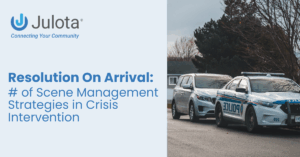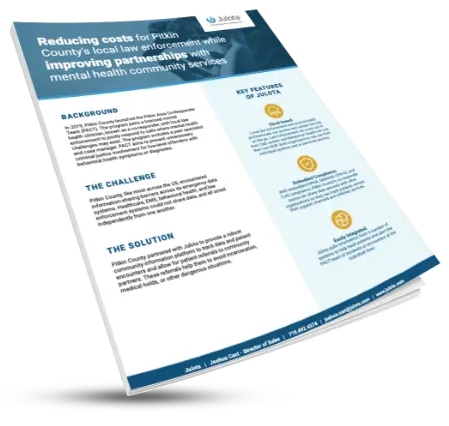- Ensuring safety and awareness before or upon arrival
- Utilizing effective communication and de-escalation during the encounter
- Concluding the call with a clinical assessment and connections to longer-term support.
Responders must work quickly to understand what triggered the situation, establish sufficient trust to facilitate open communication, and introduce practical coping strategies that can help individuals manage their emotions. The aim is not to solve everything in that moment but to prevent harm, restore a sense of control, and connect the person with resources for ongoing care.\

Scene Management Strategies in Crisis Intervention: Safety and Awareness Before Arrival
Before any client or patient contact is made, responders must make every effort to ensure the scene is safe. This begins the moment a call is dispatched. Using the information provided, responders can contact the individual who made the call to gather context about the situation and check shared platforms (such as Julota’s Interoperability Platform) to review relevant details, including diagnoses, medications, known triggers, and safety considerations like weapons in the home or prior threats toward responders. If the address is familiar from previous calls, responders can also review past notes and outcomes to anticipate potential challenges better. This preparation helps limit surprises and enables responders to arrive with a more informed and intentional plan.
Preparation starts before arrival but continues the moment you step onto the scene. As soon as responders pull up, they must reassess: What does the scene look and sound like? Take a moment to scan the area. Are bystanders calm or agitated? Does the environment appear safe enough to approach, or is staging required until additional support arrives? These split-second observations often shape the trajectory of the entire encounter.
Key Practices in Scene Safety
- Positioning and Exits – Approach carefully. When knocking on a door, stand to the side of the door frame instead of directly in front of it. Position yourself with awareness of exits and never allow bystanders or the person in crisis to block your ability to leave. Having an exit strategy in mind at all times is essential.
- Managing Bystanders – Family members, neighbors, or curious onlookers can escalate tension. Ask unnecessary people to move back and watch for signs of agitation in body language (crossed arms, pacing, or concealed items). Bysttttttttttttttttanders should never be allowed to crowd responders or interfere with the interaction.
- Environmental Awareness – Hazards extend beyond people. Aggressive animals, drug paraphernalia, hazardous materials, or even geographic features like streets/highways can complicate a call.
- Ongoing Vigilance – Even once initial contact is made, scene safety remains just below the surface of every action. Conditions can change instantly (a new person arrives, emotions spike, or environmental threats emerge). Continuous monitoring, situational flexibility, and the willingness to call for additional support are what keep both responders and clients safe. Scene safety and stability depend on never losing sight of potential risks.
The layered approach of gathering information before arrival and reassessing immediately upon arrival creates the foundation for safe and effective communication and clinical care.
Scene Management Strategies in Crisis Intervention: Communication and Rapport-Building During the Call
Once the immediate risks have been addressed and the scene is stable, the focus shifts to what may be the most decisive element of crisis intervention: communication. At this stage, responders are engaging with a person whose emotions, perceptions, and sense of control may be in turmoil. The way responders communicate can either fuel escalation or lay the groundwork for cooperation. Research in crisis intervention emphasizes that communication is not only about words, but about presence: calm tone, measured pace, open posture, and attentive listening often speak louder than any words ever could
De-escalation is, at its core, the art of building rapport under pressure. Responders must strike a balance between empathy and authority, demonstrating that they hear and understand the individual’s distress while maintaining clear boundaries to ensure safety. Effective communication requires intentional use of both verbal and non-verbal techniques: active listening, reflective statements, and offering choices paired with steady body language, respectful distance, and visible calm. When these elements come together, they can reduce the immediate intensity of a crisis and also restore a sense of dignity and agency to the individual in crisis.
Active Listening: The MOREPIE Framework
The Bexar County Crisis Intervention Team (CIT) model highlights active listening as the cornerstone of de-escalation. Their MOREPIE acronym offers a practical roadmap:
- Minimal encouragers – short cues like “Mm-hmm” or “Go on” that show attentiveness without interrupting.
- Open-ended questions – prompts that encourage fuller responses, such as “Can you tell me more about what happened today?”
- Reflecting/mirroring – repeating back key words or emotions to show you’re tuned in.
- Emotion labeling – directly naming what you hear. Labeling emotions can be especially powerful in breaking through agitation. Even simple statements such as “You sound frustrated,” “You seem overwhelmed,” “I hear that you’ve been feeling trapped.”
- Paraphrasing – summarizing in your own words: “So it sounds like you’re worried about losing your housing.” doesn’t require agreement from the other person; they show that you are trying to understand. Often, if the label is inaccurate, the individual will correct it, which still moves the conversation forward and helps strengthen rapport.
- “I” messages – expressing concern without blame: “I want to make sure you’re safe while we figure this out together.”
- Effective pauses – giving silence room to work, allowing the person to process or add more detail.
Research shows that empathy and validation lower emotional guard and increase cooperation [WSU, 2021]. These tools and strategies transform listening from a passive act into an active intervention. They validate the person’s feelings, reduce defensiveness, and demonstrate respect, all of which are critical when emotions run high.
Nonverbal and Rapport-Building Strategies
Nonverbal communication is one of the most powerful tools in crisis intervention, long before words take effect, body language, spacing, and physical demeanor shape how safe or threatened someone feels. In tense moments, even minor adjustments (how you hold your hands, how you stand, or where you place yourself) can decrease tension and create the conditions for trust.
- Hand Gestures
Open, receptive hand gestures help communicate approachability and safety. For example, showing your palms subtly signals honesty and reduces the perception of threat. Hands should remain visible, relaxed, and unclenched; hidden hands or fists can trigger suspicion or defensive responses. Movements should stay smooth and fluid, avoiding jerky or abrupt motions and fidgeting that may appear aggressive or impatient. These cues demonstrate control and calmness, inviting the person in crisis to adopt a similar state of mind. - Engagement and Space
Respecting personal space is critical. Standing too close risks overwhelming or intimidating the individual, while standing too far can signal disinterest. A balanced distance, about 1.5 to 3 feet, or roughly two arm’s lengths when safe and feasible, offers safety without making the person feel cornered. Leaning in slightly during conversation can signal interest and engagement without crossing boundaries. Another helpful tool is mirroring, which involves subtly reflecting the other person’s posture or tempo of movement to build rapport and a sense of harmony. This must be done gently and respectfully so it feels natural rather than forced. - Posture and Stance
The way responders position their bodies communicates volumes. An open posture, with uncrossed arms and relaxed shoulders, avoids signaling defensiveness or hostility. Standing slightly to the side rather than directly head-on can feel less confrontational, especially in high-stress encounters. Matching eye level: sitting if the individual is seated, crouching if safe, helps reduce power imbalances and makes the interaction feel more collaborative than authoritative. Weight distribution also matters; resting back on your heels rather than leaning forward communicates calm presence rather than aggression or pressure.
Offering Choices and Optimism
When an individual in crisis feels truly heard, the next step is to help restore their sense of agency. Crises often strip people of control; offering choices, however small, can return a measure of stability and dignity.
- Provide manageable choices. Simple, clear options like “Would you like to talk inside or outside?” or “Do you want me to sit here or over there?” can make a person feel more in control without overwhelming them. Even limited choices are powerful because they shift the dynamic to the client having a say.
- Reframe situations positively. Instead of focusing on what can’t be changed, redirect the conversation toward possibility: “Let’s think about what we can do next,” or “This feels heavy right now, but there are steps we can take together.” Optimism can provide hope and a forward-looking perspective.
- Break significant problems into smaller steps. A crisis often feels insurmountable. Responders can reduce that sense of overwhelm by breaking problems into smaller, achievable tasks: “Right now, let’s just focus on getting you some water. Then we can talk about the next step.” This creates momentum toward resolution without flooding the individual with too much at once.
- Remind them of past resilience and strengths. Many individuals have successfully navigated crises before, even if they don’t recognize it in the moment. Gentle reminders of past successes or highlighting their existing strengths can restore confidence: “I remember you told me how you handled that situation last year. You have that same strength now.” This builds self-efficacy and reinforces trust in the responder.
- Offer hope without making promises you can’t keep. Phrases like “You’re not alone in this” or “There are people who want to help” remind individuals that support exists. The focus should be on honest reassurance rather than unrealistic guarantees.
Scene Management Strategies in Crisis Intervention: Clinical Assessment After De-Escelation
When emotions begin to stabilize, responders transition into assessment and planning. This stage focuses on ensuring ongoing safety, reinforcing coping, and building bridges to long-term support.
1. Assessment
Identify immediate risks such as suicidal or homicidal ideation, grave disability, or urgent medical needs. Clarify the individual’s perception of the crisis, since understanding their perspective often reveals the most pressing concerns.
2. Support and Stabilization
Even after tension decreases, individuals may remain vulnerable. Grounding strategies, reassurance, and coping tools, like paced breathing or re-orienting questions (“What feels manageable right now?”), help maintain calm and prevent re-escalation.
3. Collaborative Planning
Planning should be short-term and achievable. Instead of overwhelming goals, responders can focus on immediate steps such as contacting a trusted friend or family member, arranging a safe place to stay, or scheduling a follow-up appointment. These small actions create momentum and give the individual a sense of control.
4. Warm Handoffs
Whenever possible, responders should actively connect the person with ongoing support, such as a walk-in crisis center, a case manager, or another treatment provider. A warm handoff means staying engaged until the connection is made, not simply leaving a resource list behind. This dramatically increases follow-through and continuity of care.
Evidence-based approaches reinforce this point. For example, Julota’s Evidence-Based Approach highlights motivational interviewing as a practical tool for fostering engagement. By helping individuals voice their own reasons for change, responders strengthen commitment to follow-up care and increase the likelihood of sustained engagement with services.
Why This Framework Matters
Scene management in crisis intervention is about using adaptable strategies that respond to the individual and the environment in front of you. Safety and awareness provide the foundation, communication and de-escalation open the door to trust, and clinical assessment and connection ensure that care continues beyond the immediate crisis.
When responders approach a call with these phases in mind, they are better equipped to stabilize chaotic situations, protect everyone involved, and link individuals to resources that support long-term recovery. Crisis intervention is most effective when it is collaborative, intentional, and grounded in evidence-based practice.




